Health and Illness in Older Persons: Arthritis Awareness for Elderly
VerifiedAdded on 2022/11/30
|10
|2228
|383
Report
AI Summary
This report, titled "Health and Illness in Older Persons: Arthritis Awareness," explores the health risks associated with arthritis, particularly among individuals aged 65 and above. It delves into the different types of arthritis, including rheumatoid arthritis and osteoarthritis, and explains how aging affects the musculoskeletal system, leading to bone loss, cartilage degradation, and reduced joint mobility. The report highlights risk factors such as family history, age, sex, previous joint injuries, and obesity, as well as environmental factors like hygiene, smoking, and occupation. It emphasizes the implications for nursing care, suggesting improvements to healthcare systems, increased staffing, and training for nurses. The report also includes a rationale for the target audience (nurses attending to elderly people) and content, explaining the importance of visual appeal and effective communication in a poster format. The justification provides a comprehensive overview of the poster's content, nursing requirements, and preventive measures to reduce the risk of developing arthritis, supported by various research studies and statistics on the prevalence of arthritis in Australia and the importance of patient education.
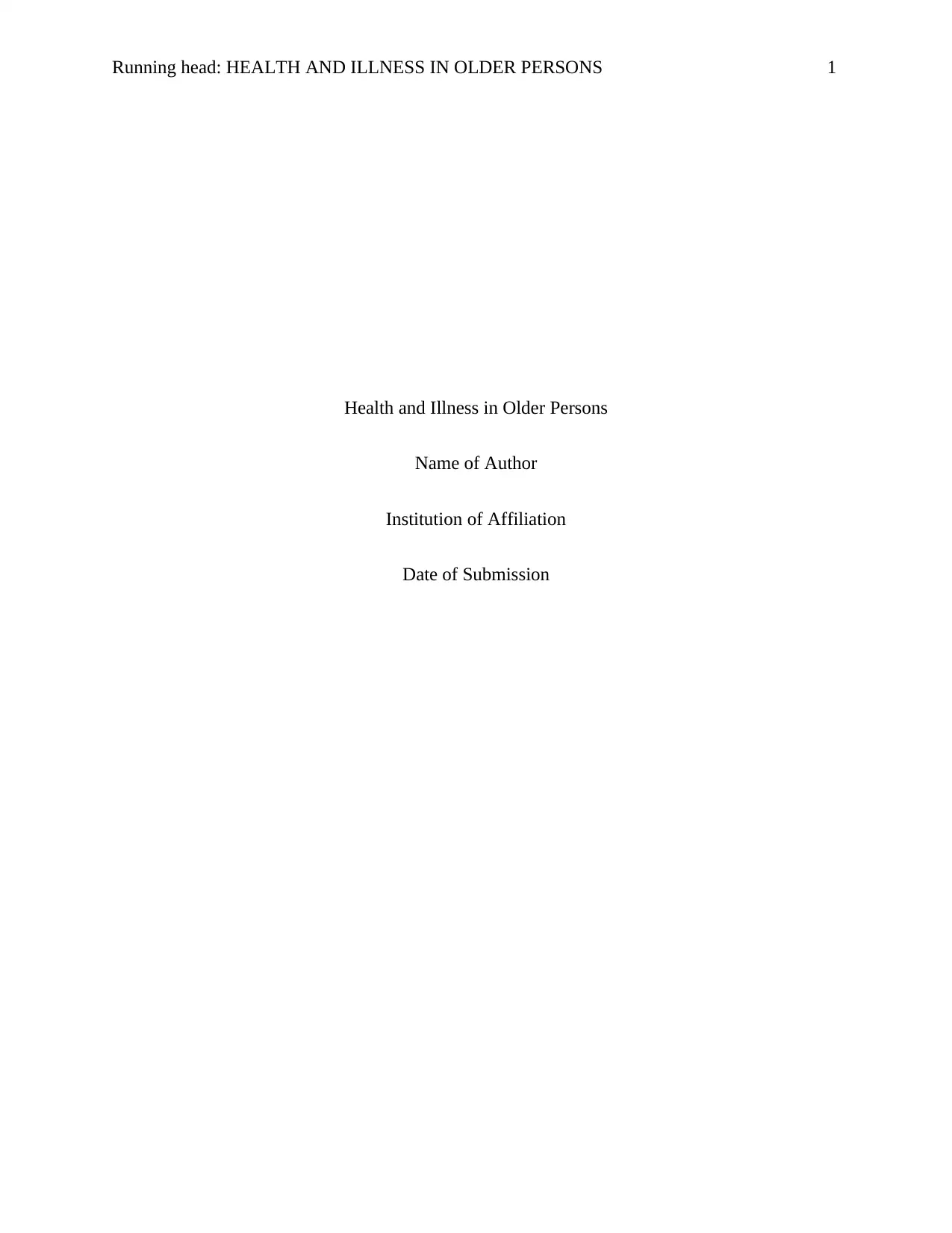
Running head: HEALTH AND ILLNESS IN OLDER PERSONS 1
Health and Illness in Older Persons
Name of Author
Institution of Affiliation
Date of Submission
Health and Illness in Older Persons
Name of Author
Institution of Affiliation
Date of Submission
Paraphrase This Document
Need a fresh take? Get an instant paraphrase of this document with our AI Paraphraser
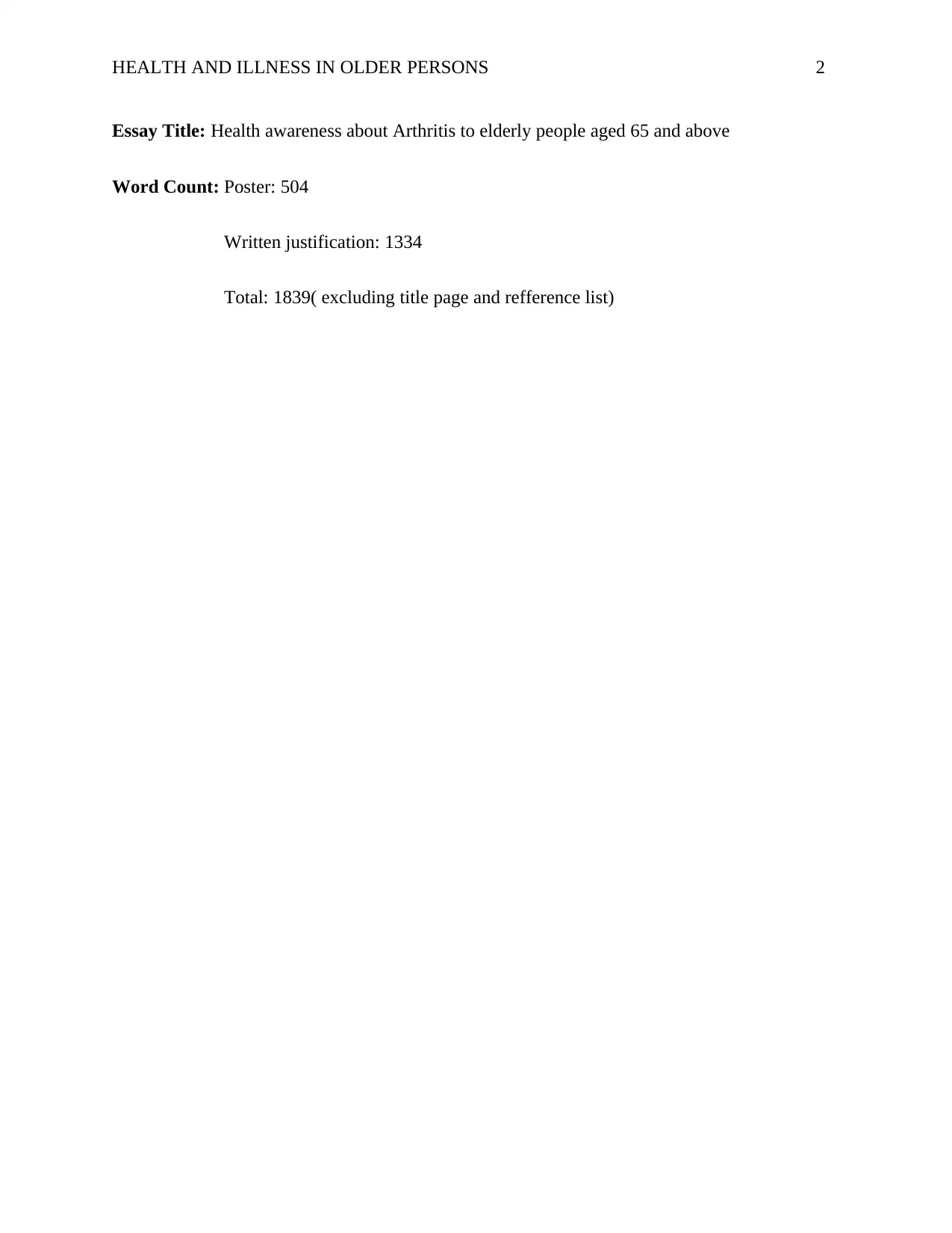
HEALTH AND ILLNESS IN OLDER PERSONS 2
Essay Title: Health awareness about Arthritis to elderly people aged 65 and above
Word Count: Poster: 504
Written justification: 1334
Total: 1839( excluding title page and refference list)
Essay Title: Health awareness about Arthritis to elderly people aged 65 and above
Word Count: Poster: 504
Written justification: 1334
Total: 1839( excluding title page and refference list)
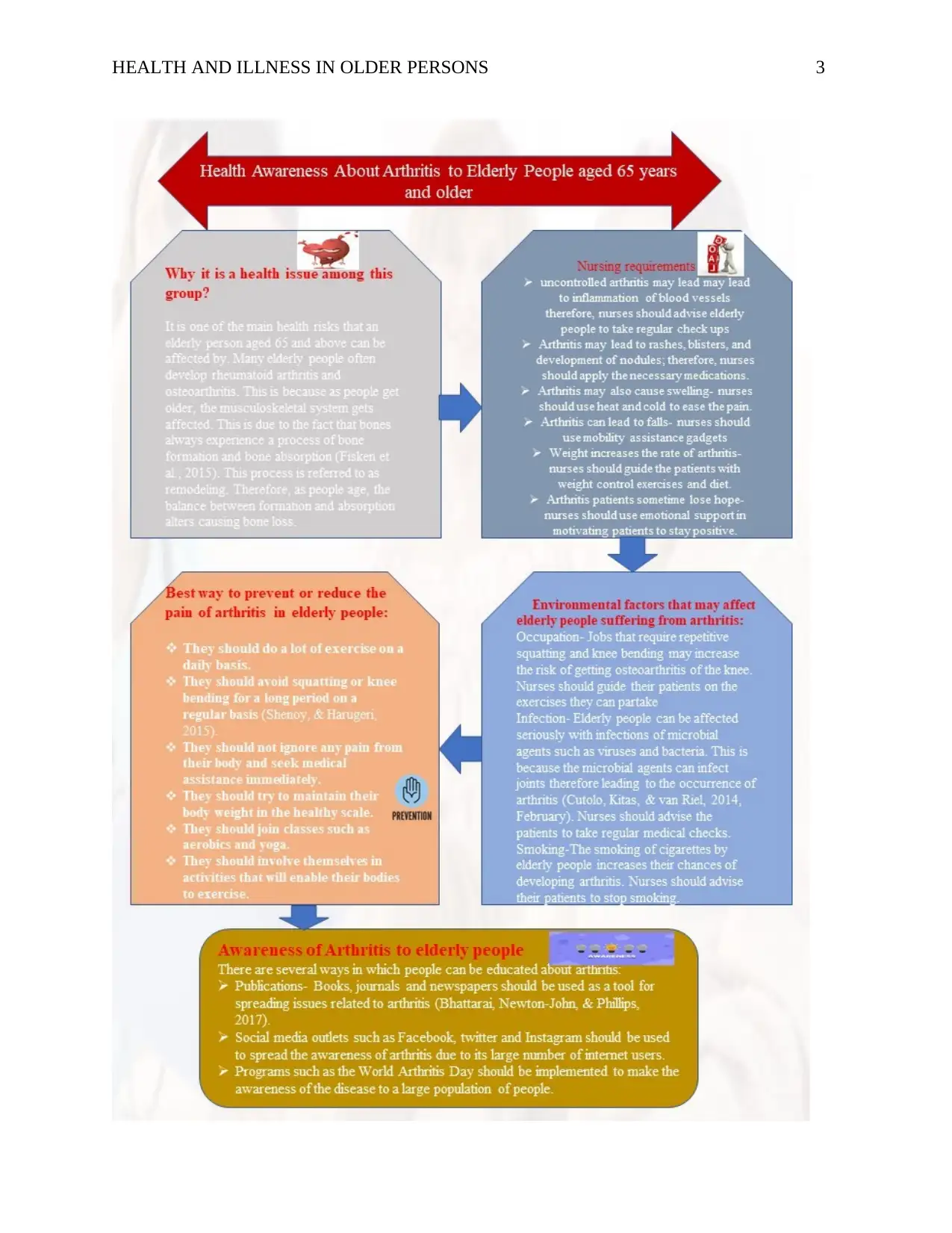
HEALTH AND ILLNESS IN OLDER PERSONS 3
⊘ This is a preview!⊘
Do you want full access?
Subscribe today to unlock all pages.

Trusted by 1+ million students worldwide
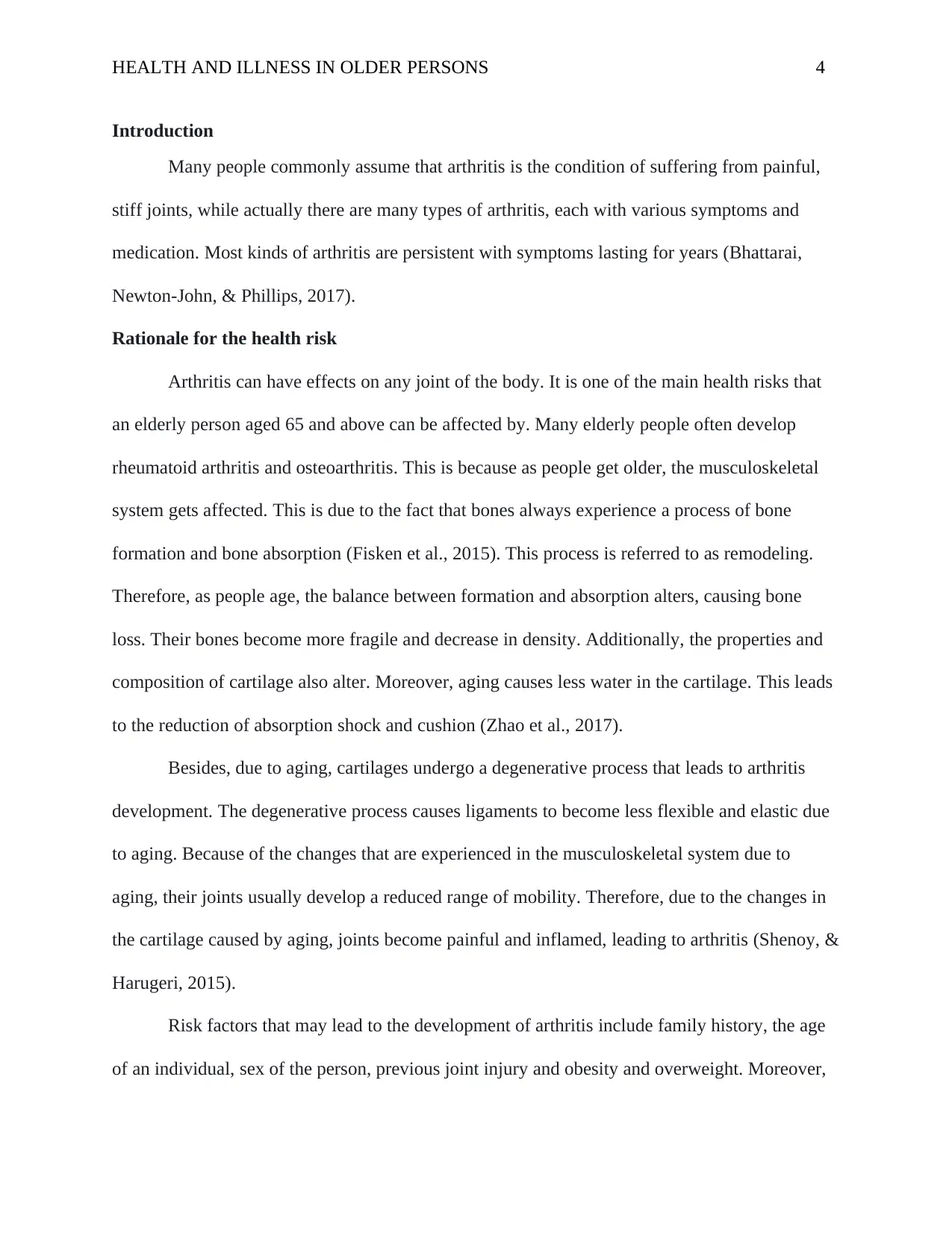
HEALTH AND ILLNESS IN OLDER PERSONS 4
Introduction
Many people commonly assume that arthritis is the condition of suffering from painful,
stiff joints, while actually there are many types of arthritis, each with various symptoms and
medication. Most kinds of arthritis are persistent with symptoms lasting for years (Bhattarai,
Newton-John, & Phillips, 2017).
Rationale for the health risk
Arthritis can have effects on any joint of the body. It is one of the main health risks that
an elderly person aged 65 and above can be affected by. Many elderly people often develop
rheumatoid arthritis and osteoarthritis. This is because as people get older, the musculoskeletal
system gets affected. This is due to the fact that bones always experience a process of bone
formation and bone absorption (Fisken et al., 2015). This process is referred to as remodeling.
Therefore, as people age, the balance between formation and absorption alters, causing bone
loss. Their bones become more fragile and decrease in density. Additionally, the properties and
composition of cartilage also alter. Moreover, aging causes less water in the cartilage. This leads
to the reduction of absorption shock and cushion (Zhao et al., 2017).
Besides, due to aging, cartilages undergo a degenerative process that leads to arthritis
development. The degenerative process causes ligaments to become less flexible and elastic due
to aging. Because of the changes that are experienced in the musculoskeletal system due to
aging, their joints usually develop a reduced range of mobility. Therefore, due to the changes in
the cartilage caused by aging, joints become painful and inflamed, leading to arthritis (Shenoy, &
Harugeri, 2015).
Risk factors that may lead to the development of arthritis include family history, the age
of an individual, sex of the person, previous joint injury and obesity and overweight. Moreover,
Introduction
Many people commonly assume that arthritis is the condition of suffering from painful,
stiff joints, while actually there are many types of arthritis, each with various symptoms and
medication. Most kinds of arthritis are persistent with symptoms lasting for years (Bhattarai,
Newton-John, & Phillips, 2017).
Rationale for the health risk
Arthritis can have effects on any joint of the body. It is one of the main health risks that
an elderly person aged 65 and above can be affected by. Many elderly people often develop
rheumatoid arthritis and osteoarthritis. This is because as people get older, the musculoskeletal
system gets affected. This is due to the fact that bones always experience a process of bone
formation and bone absorption (Fisken et al., 2015). This process is referred to as remodeling.
Therefore, as people age, the balance between formation and absorption alters, causing bone
loss. Their bones become more fragile and decrease in density. Additionally, the properties and
composition of cartilage also alter. Moreover, aging causes less water in the cartilage. This leads
to the reduction of absorption shock and cushion (Zhao et al., 2017).
Besides, due to aging, cartilages undergo a degenerative process that leads to arthritis
development. The degenerative process causes ligaments to become less flexible and elastic due
to aging. Because of the changes that are experienced in the musculoskeletal system due to
aging, their joints usually develop a reduced range of mobility. Therefore, due to the changes in
the cartilage caused by aging, joints become painful and inflamed, leading to arthritis (Shenoy, &
Harugeri, 2015).
Risk factors that may lead to the development of arthritis include family history, the age
of an individual, sex of the person, previous joint injury and obesity and overweight. Moreover,
Paraphrase This Document
Need a fresh take? Get an instant paraphrase of this document with our AI Paraphraser
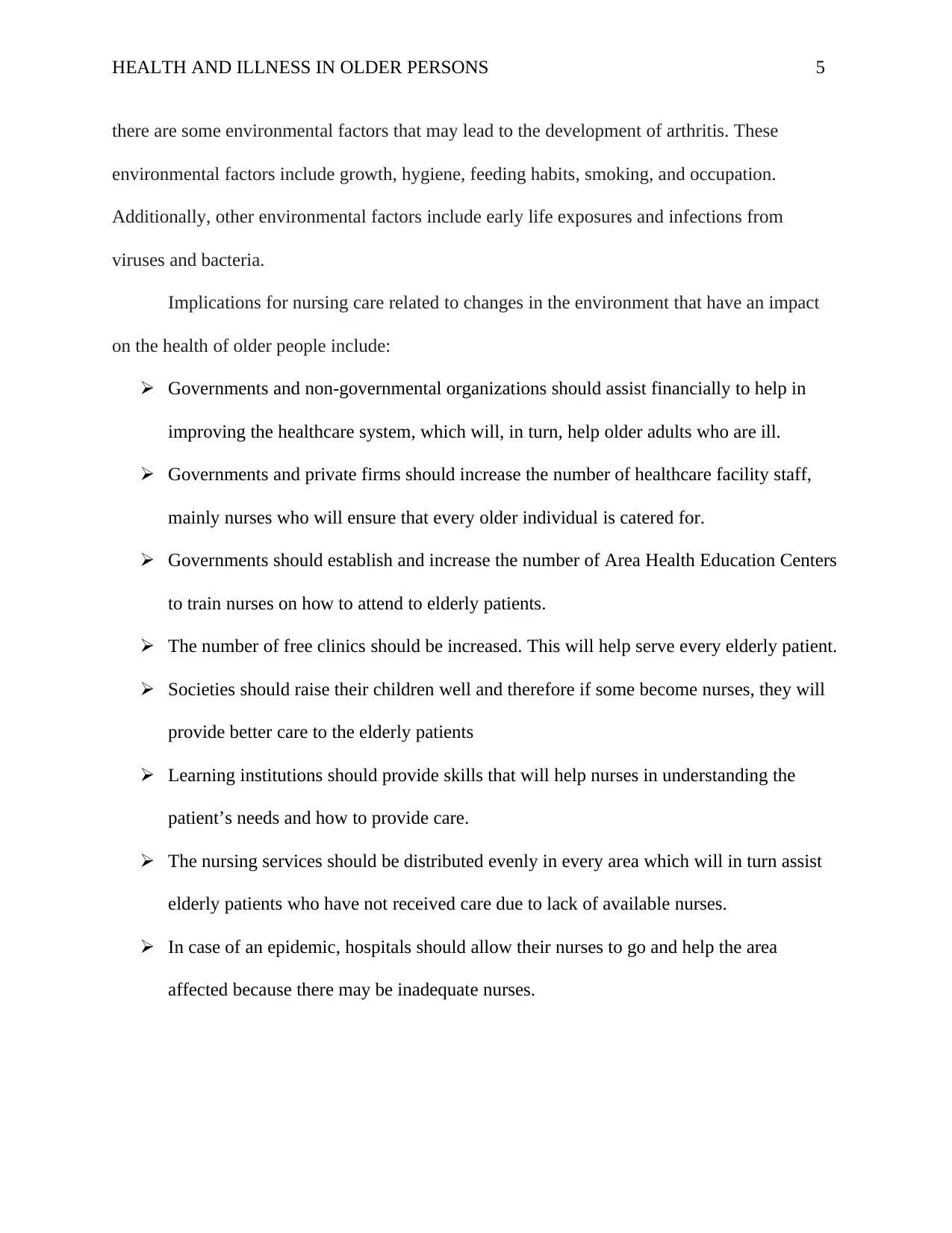
HEALTH AND ILLNESS IN OLDER PERSONS 5
there are some environmental factors that may lead to the development of arthritis. These
environmental factors include growth, hygiene, feeding habits, smoking, and occupation.
Additionally, other environmental factors include early life exposures and infections from
viruses and bacteria.
Implications for nursing care related to changes in the environment that have an impact
on the health of older people include:
Governments and non-governmental organizations should assist financially to help in
improving the healthcare system, which will, in turn, help older adults who are ill.
Governments and private firms should increase the number of healthcare facility staff,
mainly nurses who will ensure that every older individual is catered for.
Governments should establish and increase the number of Area Health Education Centers
to train nurses on how to attend to elderly patients.
The number of free clinics should be increased. This will help serve every elderly patient.
Societies should raise their children well and therefore if some become nurses, they will
provide better care to the elderly patients
Learning institutions should provide skills that will help nurses in understanding the
patient’s needs and how to provide care.
The nursing services should be distributed evenly in every area which will in turn assist
elderly patients who have not received care due to lack of available nurses.
In case of an epidemic, hospitals should allow their nurses to go and help the area
affected because there may be inadequate nurses.
there are some environmental factors that may lead to the development of arthritis. These
environmental factors include growth, hygiene, feeding habits, smoking, and occupation.
Additionally, other environmental factors include early life exposures and infections from
viruses and bacteria.
Implications for nursing care related to changes in the environment that have an impact
on the health of older people include:
Governments and non-governmental organizations should assist financially to help in
improving the healthcare system, which will, in turn, help older adults who are ill.
Governments and private firms should increase the number of healthcare facility staff,
mainly nurses who will ensure that every older individual is catered for.
Governments should establish and increase the number of Area Health Education Centers
to train nurses on how to attend to elderly patients.
The number of free clinics should be increased. This will help serve every elderly patient.
Societies should raise their children well and therefore if some become nurses, they will
provide better care to the elderly patients
Learning institutions should provide skills that will help nurses in understanding the
patient’s needs and how to provide care.
The nursing services should be distributed evenly in every area which will in turn assist
elderly patients who have not received care due to lack of available nurses.
In case of an epidemic, hospitals should allow their nurses to go and help the area
affected because there may be inadequate nurses.
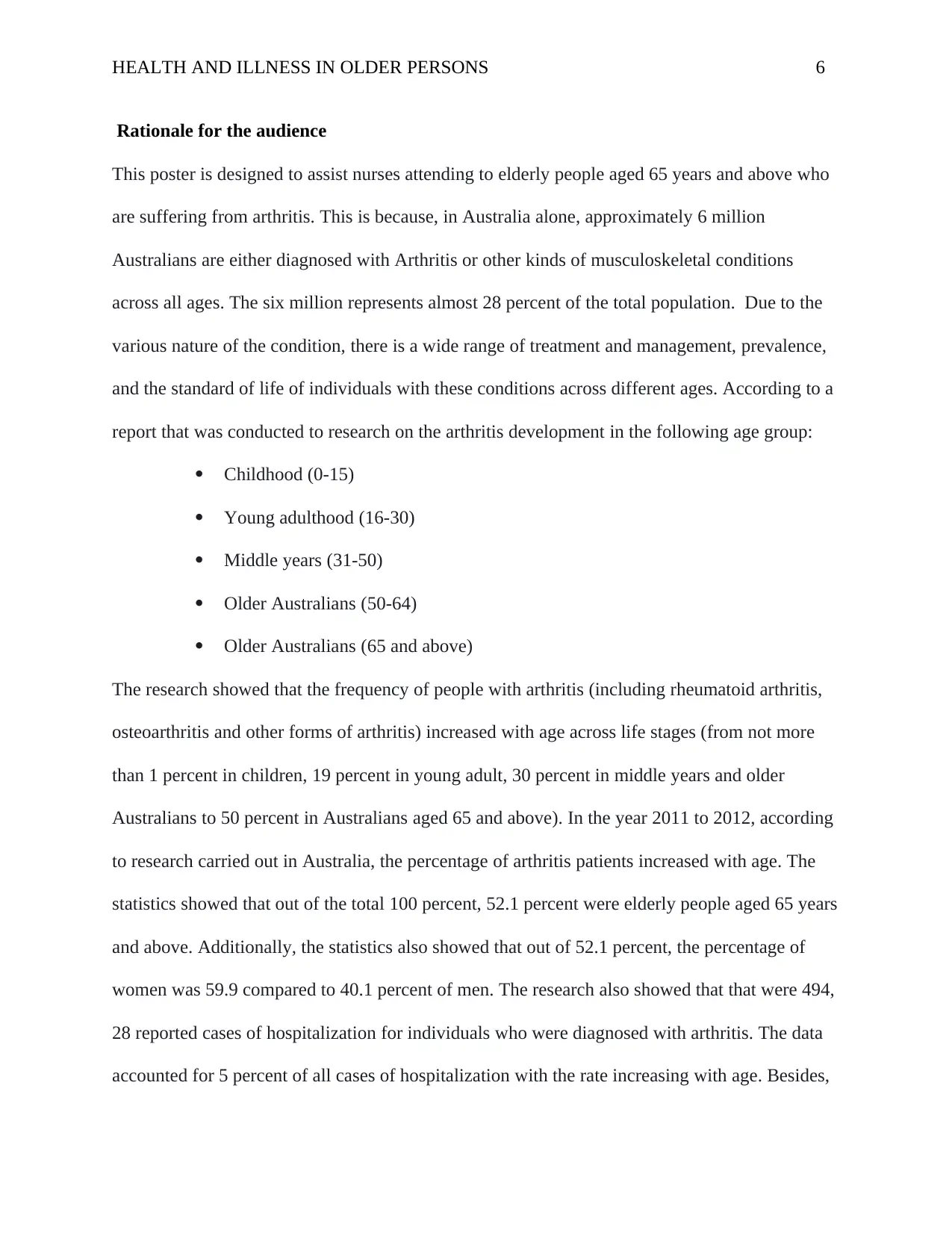
HEALTH AND ILLNESS IN OLDER PERSONS 6
Rationale for the audience
This poster is designed to assist nurses attending to elderly people aged 65 years and above who
are suffering from arthritis. This is because, in Australia alone, approximately 6 million
Australians are either diagnosed with Arthritis or other kinds of musculoskeletal conditions
across all ages. The six million represents almost 28 percent of the total population. Due to the
various nature of the condition, there is a wide range of treatment and management, prevalence,
and the standard of life of individuals with these conditions across different ages. According to a
report that was conducted to research on the arthritis development in the following age group:
Childhood (0-15)
Young adulthood (16-30)
Middle years (31-50)
Older Australians (50-64)
Older Australians (65 and above)
The research showed that the frequency of people with arthritis (including rheumatoid arthritis,
osteoarthritis and other forms of arthritis) increased with age across life stages (from not more
than 1 percent in children, 19 percent in young adult, 30 percent in middle years and older
Australians to 50 percent in Australians aged 65 and above). In the year 2011 to 2012, according
to research carried out in Australia, the percentage of arthritis patients increased with age. The
statistics showed that out of the total 100 percent, 52.1 percent were elderly people aged 65 years
and above. Additionally, the statistics also showed that out of 52.1 percent, the percentage of
women was 59.9 compared to 40.1 percent of men. The research also showed that that were 494,
28 reported cases of hospitalization for individuals who were diagnosed with arthritis. The data
accounted for 5 percent of all cases of hospitalization with the rate increasing with age. Besides,
Rationale for the audience
This poster is designed to assist nurses attending to elderly people aged 65 years and above who
are suffering from arthritis. This is because, in Australia alone, approximately 6 million
Australians are either diagnosed with Arthritis or other kinds of musculoskeletal conditions
across all ages. The six million represents almost 28 percent of the total population. Due to the
various nature of the condition, there is a wide range of treatment and management, prevalence,
and the standard of life of individuals with these conditions across different ages. According to a
report that was conducted to research on the arthritis development in the following age group:
Childhood (0-15)
Young adulthood (16-30)
Middle years (31-50)
Older Australians (50-64)
Older Australians (65 and above)
The research showed that the frequency of people with arthritis (including rheumatoid arthritis,
osteoarthritis and other forms of arthritis) increased with age across life stages (from not more
than 1 percent in children, 19 percent in young adult, 30 percent in middle years and older
Australians to 50 percent in Australians aged 65 and above). In the year 2011 to 2012, according
to research carried out in Australia, the percentage of arthritis patients increased with age. The
statistics showed that out of the total 100 percent, 52.1 percent were elderly people aged 65 years
and above. Additionally, the statistics also showed that out of 52.1 percent, the percentage of
women was 59.9 compared to 40.1 percent of men. The research also showed that that were 494,
28 reported cases of hospitalization for individuals who were diagnosed with arthritis. The data
accounted for 5 percent of all cases of hospitalization with the rate increasing with age. Besides,
⊘ This is a preview!⊘
Do you want full access?
Subscribe today to unlock all pages.

Trusted by 1+ million students worldwide
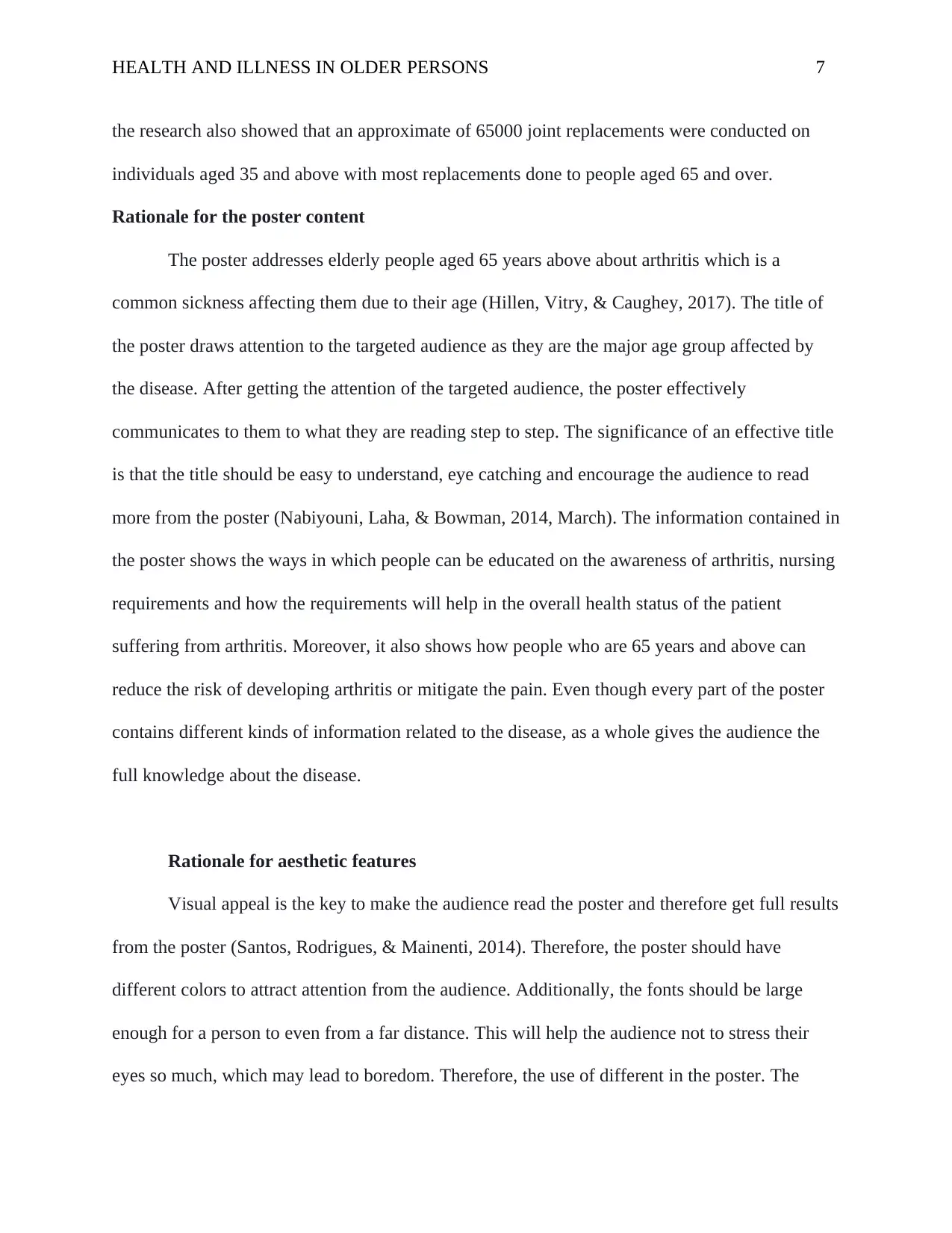
HEALTH AND ILLNESS IN OLDER PERSONS 7
the research also showed that an approximate of 65000 joint replacements were conducted on
individuals aged 35 and above with most replacements done to people aged 65 and over.
Rationale for the poster content
The poster addresses elderly people aged 65 years above about arthritis which is a
common sickness affecting them due to their age (Hillen, Vitry, & Caughey, 2017). The title of
the poster draws attention to the targeted audience as they are the major age group affected by
the disease. After getting the attention of the targeted audience, the poster effectively
communicates to them to what they are reading step to step. The significance of an effective title
is that the title should be easy to understand, eye catching and encourage the audience to read
more from the poster (Nabiyouni, Laha, & Bowman, 2014, March). The information contained in
the poster shows the ways in which people can be educated on the awareness of arthritis, nursing
requirements and how the requirements will help in the overall health status of the patient
suffering from arthritis. Moreover, it also shows how people who are 65 years and above can
reduce the risk of developing arthritis or mitigate the pain. Even though every part of the poster
contains different kinds of information related to the disease, as a whole gives the audience the
full knowledge about the disease.
Rationale for aesthetic features
Visual appeal is the key to make the audience read the poster and therefore get full results
from the poster (Santos, Rodrigues, & Mainenti, 2014). Therefore, the poster should have
different colors to attract attention from the audience. Additionally, the fonts should be large
enough for a person to even from a far distance. This will help the audience not to stress their
eyes so much, which may lead to boredom. Therefore, the use of different in the poster. The
the research also showed that an approximate of 65000 joint replacements were conducted on
individuals aged 35 and above with most replacements done to people aged 65 and over.
Rationale for the poster content
The poster addresses elderly people aged 65 years above about arthritis which is a
common sickness affecting them due to their age (Hillen, Vitry, & Caughey, 2017). The title of
the poster draws attention to the targeted audience as they are the major age group affected by
the disease. After getting the attention of the targeted audience, the poster effectively
communicates to them to what they are reading step to step. The significance of an effective title
is that the title should be easy to understand, eye catching and encourage the audience to read
more from the poster (Nabiyouni, Laha, & Bowman, 2014, March). The information contained in
the poster shows the ways in which people can be educated on the awareness of arthritis, nursing
requirements and how the requirements will help in the overall health status of the patient
suffering from arthritis. Moreover, it also shows how people who are 65 years and above can
reduce the risk of developing arthritis or mitigate the pain. Even though every part of the poster
contains different kinds of information related to the disease, as a whole gives the audience the
full knowledge about the disease.
Rationale for aesthetic features
Visual appeal is the key to make the audience read the poster and therefore get full results
from the poster (Santos, Rodrigues, & Mainenti, 2014). Therefore, the poster should have
different colors to attract attention from the audience. Additionally, the fonts should be large
enough for a person to even from a far distance. This will help the audience not to stress their
eyes so much, which may lead to boredom. Therefore, the use of different in the poster. The
Paraphrase This Document
Need a fresh take? Get an instant paraphrase of this document with our AI Paraphraser
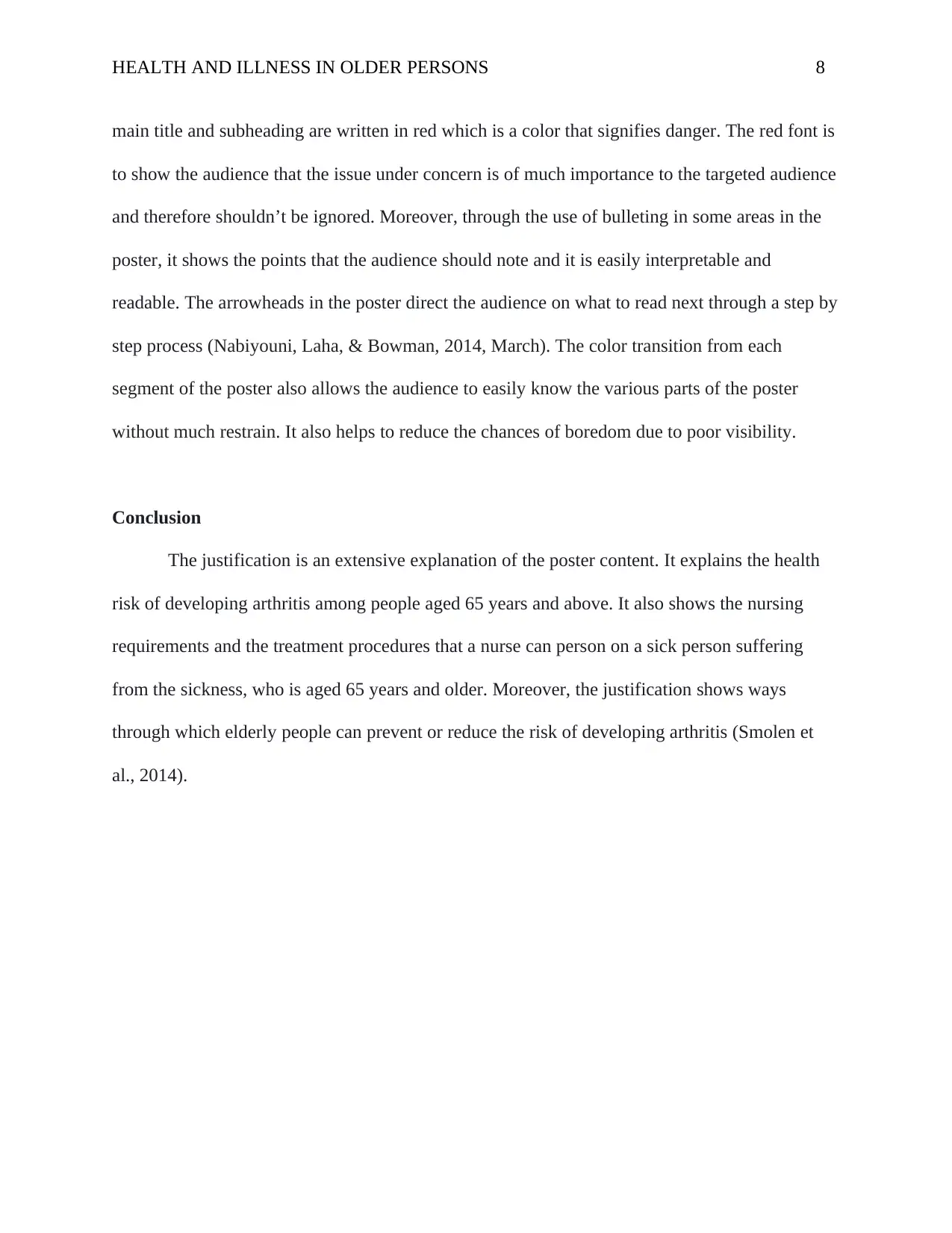
HEALTH AND ILLNESS IN OLDER PERSONS 8
main title and subheading are written in red which is a color that signifies danger. The red font is
to show the audience that the issue under concern is of much importance to the targeted audience
and therefore shouldn’t be ignored. Moreover, through the use of bulleting in some areas in the
poster, it shows the points that the audience should note and it is easily interpretable and
readable. The arrowheads in the poster direct the audience on what to read next through a step by
step process (Nabiyouni, Laha, & Bowman, 2014, March). The color transition from each
segment of the poster also allows the audience to easily know the various parts of the poster
without much restrain. It also helps to reduce the chances of boredom due to poor visibility.
Conclusion
The justification is an extensive explanation of the poster content. It explains the health
risk of developing arthritis among people aged 65 years and above. It also shows the nursing
requirements and the treatment procedures that a nurse can person on a sick person suffering
from the sickness, who is aged 65 years and older. Moreover, the justification shows ways
through which elderly people can prevent or reduce the risk of developing arthritis (Smolen et
al., 2014).
main title and subheading are written in red which is a color that signifies danger. The red font is
to show the audience that the issue under concern is of much importance to the targeted audience
and therefore shouldn’t be ignored. Moreover, through the use of bulleting in some areas in the
poster, it shows the points that the audience should note and it is easily interpretable and
readable. The arrowheads in the poster direct the audience on what to read next through a step by
step process (Nabiyouni, Laha, & Bowman, 2014, March). The color transition from each
segment of the poster also allows the audience to easily know the various parts of the poster
without much restrain. It also helps to reduce the chances of boredom due to poor visibility.
Conclusion
The justification is an extensive explanation of the poster content. It explains the health
risk of developing arthritis among people aged 65 years and above. It also shows the nursing
requirements and the treatment procedures that a nurse can person on a sick person suffering
from the sickness, who is aged 65 years and older. Moreover, the justification shows ways
through which elderly people can prevent or reduce the risk of developing arthritis (Smolen et
al., 2014).
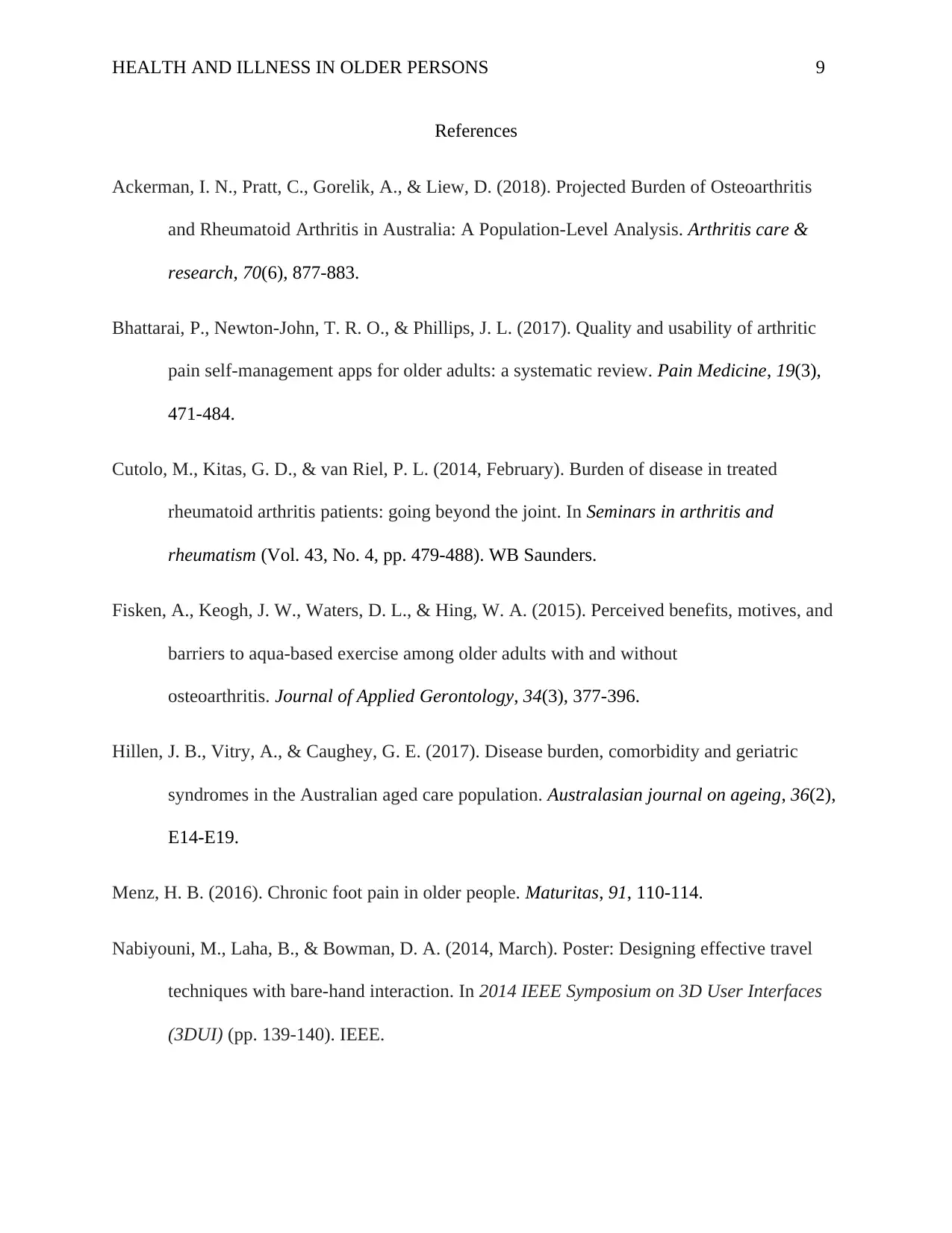
HEALTH AND ILLNESS IN OLDER PERSONS 9
References
Ackerman, I. N., Pratt, C., Gorelik, A., & Liew, D. (2018). Projected Burden of Osteoarthritis
and Rheumatoid Arthritis in Australia: A Population‐Level Analysis. Arthritis care &
research, 70(6), 877-883.
Bhattarai, P., Newton-John, T. R. O., & Phillips, J. L. (2017). Quality and usability of arthritic
pain self-management apps for older adults: a systematic review. Pain Medicine, 19(3),
471-484.
Cutolo, M., Kitas, G. D., & van Riel, P. L. (2014, February). Burden of disease in treated
rheumatoid arthritis patients: going beyond the joint. In Seminars in arthritis and
rheumatism (Vol. 43, No. 4, pp. 479-488). WB Saunders.
Fisken, A., Keogh, J. W., Waters, D. L., & Hing, W. A. (2015). Perceived benefits, motives, and
barriers to aqua-based exercise among older adults with and without
osteoarthritis. Journal of Applied Gerontology, 34(3), 377-396.
Hillen, J. B., Vitry, A., & Caughey, G. E. (2017). Disease burden, comorbidity and geriatric
syndromes in the Australian aged care population. Australasian journal on ageing, 36(2),
E14-E19.
Menz, H. B. (2016). Chronic foot pain in older people. Maturitas, 91, 110-114.
Nabiyouni, M., Laha, B., & Bowman, D. A. (2014, March). Poster: Designing effective travel
techniques with bare-hand interaction. In 2014 IEEE Symposium on 3D User Interfaces
(3DUI) (pp. 139-140). IEEE.
References
Ackerman, I. N., Pratt, C., Gorelik, A., & Liew, D. (2018). Projected Burden of Osteoarthritis
and Rheumatoid Arthritis in Australia: A Population‐Level Analysis. Arthritis care &
research, 70(6), 877-883.
Bhattarai, P., Newton-John, T. R. O., & Phillips, J. L. (2017). Quality and usability of arthritic
pain self-management apps for older adults: a systematic review. Pain Medicine, 19(3),
471-484.
Cutolo, M., Kitas, G. D., & van Riel, P. L. (2014, February). Burden of disease in treated
rheumatoid arthritis patients: going beyond the joint. In Seminars in arthritis and
rheumatism (Vol. 43, No. 4, pp. 479-488). WB Saunders.
Fisken, A., Keogh, J. W., Waters, D. L., & Hing, W. A. (2015). Perceived benefits, motives, and
barriers to aqua-based exercise among older adults with and without
osteoarthritis. Journal of Applied Gerontology, 34(3), 377-396.
Hillen, J. B., Vitry, A., & Caughey, G. E. (2017). Disease burden, comorbidity and geriatric
syndromes in the Australian aged care population. Australasian journal on ageing, 36(2),
E14-E19.
Menz, H. B. (2016). Chronic foot pain in older people. Maturitas, 91, 110-114.
Nabiyouni, M., Laha, B., & Bowman, D. A. (2014, March). Poster: Designing effective travel
techniques with bare-hand interaction. In 2014 IEEE Symposium on 3D User Interfaces
(3DUI) (pp. 139-140). IEEE.
⊘ This is a preview!⊘
Do you want full access?
Subscribe today to unlock all pages.

Trusted by 1+ million students worldwide
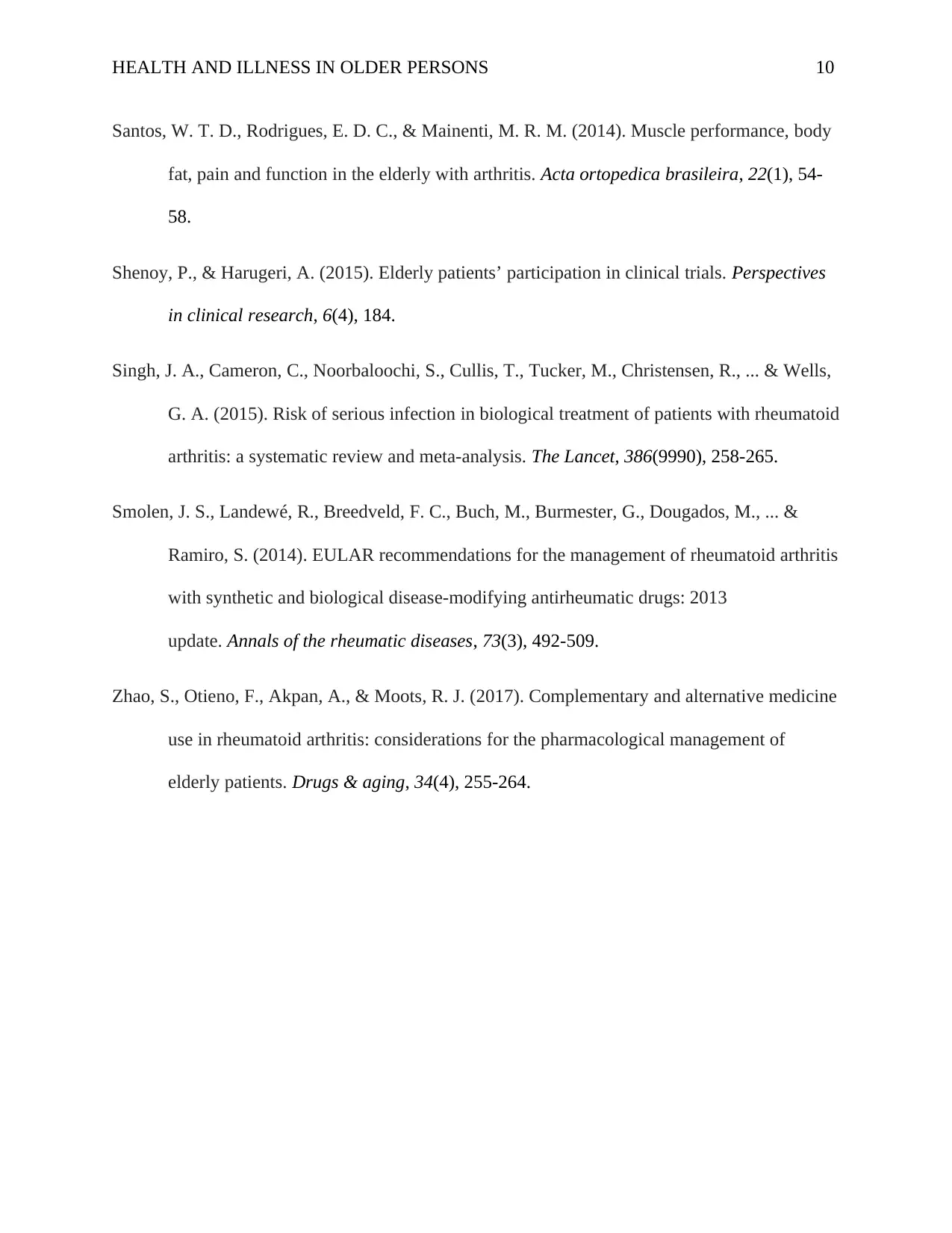
HEALTH AND ILLNESS IN OLDER PERSONS 10
Santos, W. T. D., Rodrigues, E. D. C., & Mainenti, M. R. M. (2014). Muscle performance, body
fat, pain and function in the elderly with arthritis. Acta ortopedica brasileira, 22(1), 54-
58.
Shenoy, P., & Harugeri, A. (2015). Elderly patients’ participation in clinical trials. Perspectives
in clinical research, 6(4), 184.
Singh, J. A., Cameron, C., Noorbaloochi, S., Cullis, T., Tucker, M., Christensen, R., ... & Wells,
G. A. (2015). Risk of serious infection in biological treatment of patients with rheumatoid
arthritis: a systematic review and meta-analysis. The Lancet, 386(9990), 258-265.
Smolen, J. S., Landewé, R., Breedveld, F. C., Buch, M., Burmester, G., Dougados, M., ... &
Ramiro, S. (2014). EULAR recommendations for the management of rheumatoid arthritis
with synthetic and biological disease-modifying antirheumatic drugs: 2013
update. Annals of the rheumatic diseases, 73(3), 492-509.
Zhao, S., Otieno, F., Akpan, A., & Moots, R. J. (2017). Complementary and alternative medicine
use in rheumatoid arthritis: considerations for the pharmacological management of
elderly patients. Drugs & aging, 34(4), 255-264.
Santos, W. T. D., Rodrigues, E. D. C., & Mainenti, M. R. M. (2014). Muscle performance, body
fat, pain and function in the elderly with arthritis. Acta ortopedica brasileira, 22(1), 54-
58.
Shenoy, P., & Harugeri, A. (2015). Elderly patients’ participation in clinical trials. Perspectives
in clinical research, 6(4), 184.
Singh, J. A., Cameron, C., Noorbaloochi, S., Cullis, T., Tucker, M., Christensen, R., ... & Wells,
G. A. (2015). Risk of serious infection in biological treatment of patients with rheumatoid
arthritis: a systematic review and meta-analysis. The Lancet, 386(9990), 258-265.
Smolen, J. S., Landewé, R., Breedveld, F. C., Buch, M., Burmester, G., Dougados, M., ... &
Ramiro, S. (2014). EULAR recommendations for the management of rheumatoid arthritis
with synthetic and biological disease-modifying antirheumatic drugs: 2013
update. Annals of the rheumatic diseases, 73(3), 492-509.
Zhao, S., Otieno, F., Akpan, A., & Moots, R. J. (2017). Complementary and alternative medicine
use in rheumatoid arthritis: considerations for the pharmacological management of
elderly patients. Drugs & aging, 34(4), 255-264.
1 out of 10
Related Documents
Your All-in-One AI-Powered Toolkit for Academic Success.
+13062052269
info@desklib.com
Available 24*7 on WhatsApp / Email
![[object Object]](/_next/static/media/star-bottom.7253800d.svg)
Unlock your academic potential
Copyright © 2020–2025 A2Z Services. All Rights Reserved. Developed and managed by ZUCOL.





